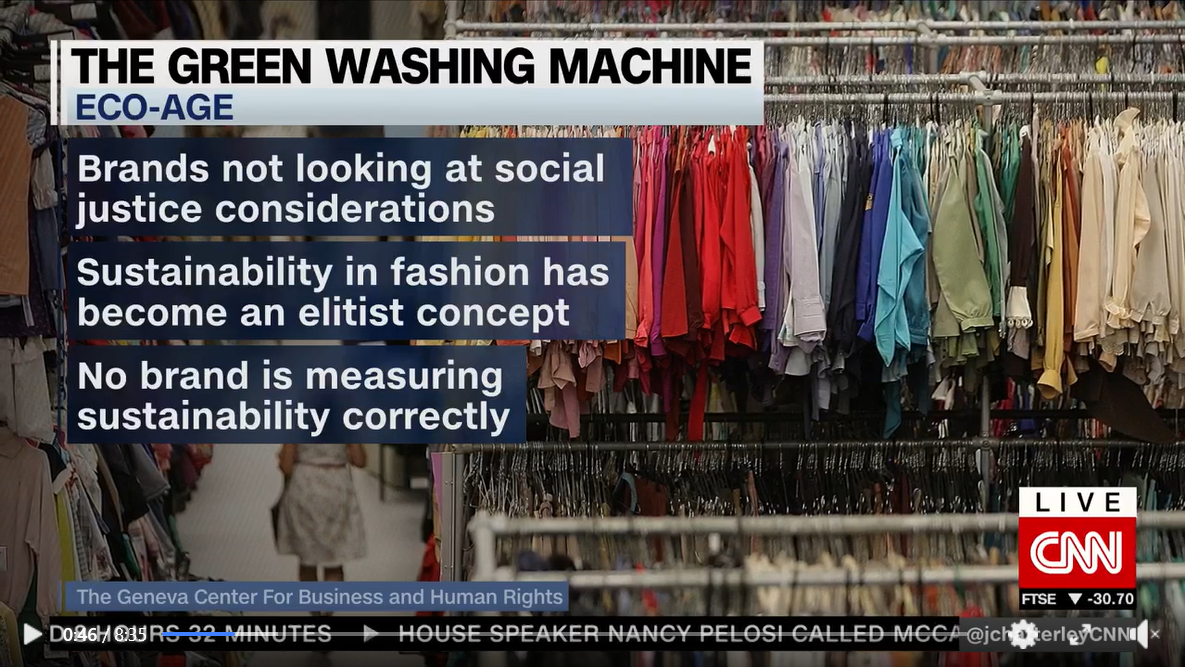The Great Greenwashing Machine - Part 1: Back to the Roots of Sustainability
Today, major fashion brands claim to be engaged in sustainability efforts, but as this new report reveals, many are failing in their efforts because they are using a flawed definition of sustainability, unscientific methods and selective implementation.
The report, titled The Great Greenwashing Machine - Part 1: Back to the Roots of Sustainability (PDF), authored by Veronica Bates Kassatly and Dorothée Baumann-Pauly and supported by leading sustainability consultancy Eco-Age, examines sustainable fashion claims and critically assesses the extent to which fashion’s efforts are contributing to meaningful change, and to what extent they are a distraction.
The fashion industry is considered as a major contributor to air, water, and soil pollution, as well as an enabler of exploitative sweatshop conditions for garment workers – this reputation is bad for business, so in response, fashion brands have created sustainability programs to assure governments, consumers and investors that they are addressing their social and environmental impact.
Despite these well-meaning industry efforts, the perceived holistic sustainability benefits do not appear to be trickling down to the producers, some of the least represented and underpaid in fashion’s global value chain. The vast majority of those living below the social foundation are to be found in the global south. Yet not only are their needs not given priority, but the global south does not even appear to be represented in any of the major sustainability initiatives and groups. Nor do Zambian or Burkinabe cotton farmers, Brazilian silk, or Peruvian alpaca farmers appear to be consulted at any of the major fashion weeks or conferences.
This report first outlines the definition of sustainability, going back to the roots of origin in the 1987 United Nations World Commission on Environment and Development – also known as the Brundtland Commission – that underpins the UN Sustainable Development Goals (SDGs) to this day.
It then delves into a critical assessment of how current sustainability claims in fashion deviate from the Brundtland definition and exposes the vast consequences and outcomes resulting from fashion’s failure to meet it.
The first report in the series provides two concrete measures, with three associated action points for policymakers and corporations; the aim of which is to ensure that in meeting the needs of the present without compromising the ability of future generations to meet their own needs, overriding priority is given to meeting the essential needs of the world’s poor.
Authors: Veronica Bates Kassatly & Dorothée Baumann-Pauly
Date: 15 September 2021
Publisher: Eco-Age
To download this report and discover quotes from the authors and from Livia Firth, please scroll down the page.
Quotes
Veronica Bates Kassatly, Independent Analyst said: “At the present time there does not appear to be a single initiative or brand that is measuring sustainability correctly. They all appear to conflate sustainability with environmental impact – which they don’t even calculate accurately. And they all make claims and recommendations without once considering the repercussions of these assertions on the livelihoods of millions, primarily in the global south. This is a direct violation of commitments to the UN SDGs and has potentially profound adverse consequences for both planet and people.”
Professor Dorothée Baumann-Pauly, Director of The Geneva Center for Business and Human Rights said: “There is growing skepticism over self-proclaimed sustainability in the fashion industry. The North Star however, is the 1987 Brundtland definition of sustainability. It is in the interest of industry to develop science-based standards and metrics that are aligned with this original and comprehensive understanding of sustainability which explicitly includes human rights. Clear standards can prevent greenwashing and allow companies to showcase that they are making progress towards sustainability. They can also serve as a guide through the dense jungle of sustainable fashion initiatives.”
Livia Firth, Creative Director and Founder of Eco-Age said: “I am proud to announce that today, with Eco-Age, we support the launch of a ground-breaking report on the state of sustainability in the fashion industry, published in association with The Geneva Center for Business and Human Rights. We did this as after 12 years of operating as the leading agency on sustainable business strategies and communications, we are alarmed by the lack of scientific data backing companies’ reporting and marketing.”
Media coverage
- The Guardian, Fashion faces a stark choice: stop flogging cheap clothes or go out of style, by Jess Cartner-Morley (16 September 2021)
- Fibershed, ‘Sustainable’ Fashion Forgot Where It Came From, by Veronica Bates Kassalty (22 September 2021)
- Green Queen, Fashion Industry Rife with False Sustainability Promises: New Report, by Sally Ho (24 September 2021) [reach: 564,570]
- Women’s Wear Daily, By 2023, Clothes in EU Need Eco Label, Campaigners Worry It’s ‘Incomplete’ at Present, by Kaley Roshitsh (13 October 2021)
- Head Topics, By 2023, Clothes in EU Need Eco Label, Campaigners Worry It’s ‘Incomplete’ at Present (14 October 2021)
- Sourcing Journal, Fashion’s Achilles Heel? Greenwashing, by Jasmin Malik Chua (15 October 2021)
- Apparel Insider, Elitist, imperialistic – new briefing slams fashion’s sustainability model, by Brett Mathews (17 October 2021)
- Impakter, Paris Fashion Week: Can the Fashion Industry Deliver on Sustainability Promises?, by Henrietta McFarlane (18 October 2021)
- Fast Company, You thought the pandemic killed fast fashion? Not even close, by Elizabeth Segran (22 October 2021)


